Making and How to Make Model Deciduous Trees
Christmas Village Displays

There are certainly all kinds of different ways that you can make model deciduous trees on a budget. All that you really need is access to a well-stocked garden and a little imagination.
Any shrubs or hedges that have been routinely clipped over the years are likely to be an excellent source of twiggy branches, ideal for using as miniature-scale trees. Take time to carefully select an interesting branch line, which will ultimately become the trunk, making sure that there is a relatively even distribution of twigs along each side.
Even if you are only planning a small village, the effect of adding clumps of trees will make a huge difference to the overall effect, so get pruning! Trimmed hedges such as privet (ligustrum) and azalea (rhododendron) bushes yield especially good branches, as do heathers (ericas) and many dried flowers with strong stems.
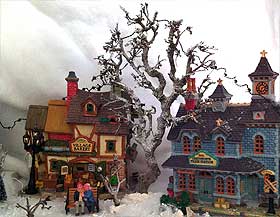
Making Model Trees from Twigs and Branches
If you have found the perfect branch, yet it is lacking enough twigs, these can always be glued or wired on in strategic places. Once trimmed to size, it is essential that any model tree is given a solid and stable base, that is coloured white to blend in with the winter snow scene.
Modelling clay is perfect for a base, since it dries naturally and quickly, remaining quite heavy. You can also make bases by using white cardboard with a big blob of white silicone sealant, supporting the tree in place until the sealant has dried.
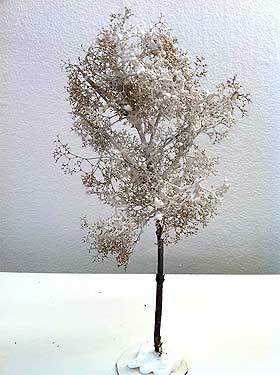
How to Make Model Seafoam Trees
Model shops often sell an interesting, unusual dried plant called 'seafoam'. This extremely delicate and intricate plant is actually named 'teloxys aristata' (also known as tumbleweed) and whilst a box of dried stems is relatively inexpensive, those with green fingers may like to try growing their own seafoam plants from seed, during the spring and summer months, harvesting the colourful stems in the autumn.
Making model trees from seafoam is as simple as selecting a decent stem from your box of seafoam pieces, trimming it to size and shape (exposing a 'trunk') and inserting it into a base of either thick glue or modelling clay.
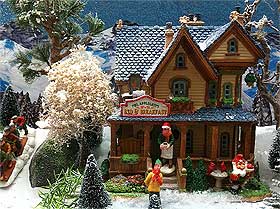
Bent stems can easily be straightened by soaking them in boiling water for a few minutes, and larger trees can be created by joining several stems together with glue.
If you want the trees to have some green foliage, then spray them with glue and dust the sprigs liberally with green 'leaf powder' from a model shop. This can be extremely effective, particularly when this process is repeated several times. Alternatively, spray the trees white and then finish them off with a generous covering of snow spray.
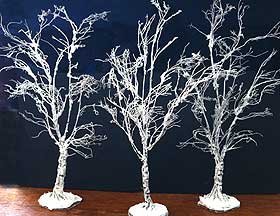
How to Make Model Silver Birch Trees
A very effective and surprisingly lifelike silver birch tree can be created by using a mixture of different stems. The trees pictured here were actually very simple to make, using the old seed heads from a herbaceous crocosmia (montbretia) plant.
Several were bound together with masking tape and then fine twigs were created by glueing on the shrubby growth from woody thyme sprigs from a herb garden.
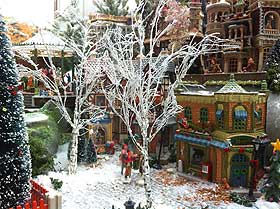
A quick spray with white paint transformed the overall effect, as did the addition of some black lines painted on the trunk with a fine paintbrush. These trunk markings are so typical of silver birches. It is often easier and timesaving to make multiple batches of miniature trees together, and since they are all just made with plants from the garden, the cost is limited to craft cupboard staples - glue and paint.
When creating the base, do invest a little extra time to try and craft a realistic buttress, with strong surface roots providing a natural feeling of stability.
 There are certainly all kinds of different ways that you can make model deciduous trees on a budget. All that you really need is access to a well-stocked garden and a little imagination.
There are certainly all kinds of different ways that you can make model deciduous trees on a budget. All that you really need is access to a well-stocked garden and a little imagination.

 Bent stems can easily be straightened by soaking them in boiling water for a few minutes, and larger trees can be created by joining several stems together with glue.
Bent stems can easily be straightened by soaking them in boiling water for a few minutes, and larger trees can be created by joining several stems together with glue.
 A quick spray with white paint transformed the overall effect, as did the addition of some black lines painted on the trunk with a fine paintbrush. These trunk markings are so typical of silver birches. It is often easier and timesaving to make multiple batches of miniature trees together, and since they are all just made with plants from the garden, the cost is limited to craft cupboard staples - glue and paint.
A quick spray with white paint transformed the overall effect, as did the addition of some black lines painted on the trunk with a fine paintbrush. These trunk markings are so typical of silver birches. It is often easier and timesaving to make multiple batches of miniature trees together, and since they are all just made with plants from the garden, the cost is limited to craft cupboard staples - glue and paint.